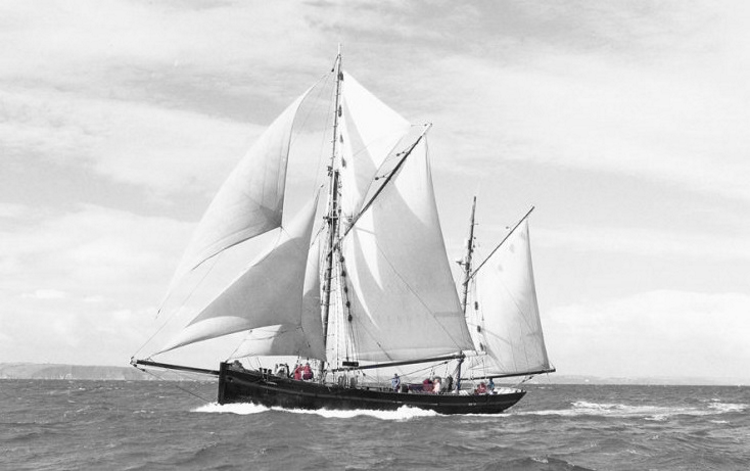
Sail Number:
Vessel Type: Gaff Rigged Ketch (Class B)
LOA: 100’0″ / 30.50mm – LOD: 80’0″ / 24.40m – LWL: 68’3″ / 20.80m – Beam: 19’4″ / 5.90m – Draft: 9’10” / 3.00m – Displacement: 110 tons / 100 tonnes – Ballast: 16.5 tons / 15 tonnes – Sail Area: 2390 sq ft / 222 sq m – Original Name: – Original Owner: – Designed by: – Launched: 1892 – Built by: W. A. Gibbs’ yard, Galmpton, River Dart, Devon – Hull Material: Wood – Location: – Flag: Brixham, United Kingdom
Historical:
Leader was one of the largest of the Brixham sailing trawlers, known, despite their Ketch rigs, as the ‘Big Sloops’.
At 105 feet in length and with a displacement of 110 tonnes, Leader is the largest and oldest boat in the Trinity Sailing Foundation fleet, carrying a total 3,150 square feet of sail on a gaff ketch rig. Built in Devon in 1892, Leader originally fished in UK waters until 1907 when she was sold to new owners to operate off Sweden’s west coast. In 1970 Leader changed ownership again, becoming a sail training vessel for the Swedish Cruising Club.
In 1985 she began offering sailing holidays and charter opportunities off the west coast of Scotland under the name of ‘Lorne Leader’. In 1996 she was brought home to South Devon to operate out of Dartmouth before officially becoming a part of the Trinity fleet in 1999 at her new home port of Brixham. With help from the Heritage Lottery Fund she was then restored and modernised during the ‘Leader Project’ which featured as a part of the Channel 4 series ‘How Britain Worked’.
Leader now operates with a modern navigation system, accommodation for twelve guests and five crew, a large saloon area, modern galley, two heads and two hot showers. Her programme throughout the year sees her offer anything from charter to RYA courses, Sail Training and even DofE Gold Residential voyages with no prior experience required to get on board. You’ll also regularly see her attending many key tall ships events across the UK.
The Leader Project (2011-2012)
The Trinity Sailing Foundation – It had become apparent that whilst Leader’s hull and rig were in excellent condition, her main deck and the bulwarks and stanchions that surround it were in need of replacement, having last been renewed in the 1960’s.
Leader’s deck is 80 feet in length and 19 feet wide, with 36 planks at the point of maximum beam. It is made of two-inch thick Douglas Fir planking, resting on massive oak beams, which in turn are supported by an oak beam shelf that runs round the inside of the hull.
The stanchions and the high bulwarks that are attached to them are one of the things that make ‘Leader’ and her sister ships safe and stable working platforms, ideal for their sail training role. The stanchions are made of six-inch square oak, and in addition to the part which projects above the deck they continue for several feet below deck level, where they are fastened to the main frames of the ship. There are 25 stanchions on each side of the ship. The planking of the bulwarks is in Douglas Fir, and is capped by a substantial oak rail.
Over the years the loads exerted by the rigging had caused the vessel’s sheer – the smooth curve of the deck from bow to stern – to become distorted, or “hogged”, to a certain degree, and therefore Trinity also wanted to take the opportunity to correct that.
Because of the high costs involved with replacing the deck, bulwarks and stanchions, (which could not be met through our day to day work) Trinity approached the Heritage Lottery Fund for funding to support this vital project. After being awarded an initial Development grant and nearly two years after first approaching the Heritage Lottery Fund South-West, in November 2011 Trinity received the fantastic news it had been awarded a grant of £170,000 towards restoring Leader.
The project had three main objectives:
- The replacement of the 40-year-old main weather-deck bulwarks and stanchions, replacement of some deck beams and the elimination of “hogging” that had deformed the originally smooth lines of the vessel’s sheer.
- To attract and educate the public, provide opportunities for volunteers to participate and learn skills, and opportunities to train professional crew in Shipwright’s skills.
- To develop heritage information and exhibitions, and work with schools and colleges to produce education resources and provide opportunities for hands-on experiences.
An overview of the key results from the project:
* Restoration & capital works: The work to Leader was completed in May 2012. During that time local shipwrights, Trinity staff and volunteers worked to replace the deck, bulwarks and stanchions and eliminate the “hogging”. Both the MCA surveyor and the HLF appointed Project Monitor commented on the high quality of the workmanship that had been undertaken. We have also had great feedback from the crew and clients who have sailed on her since.
Promoting our maritime heritage:
Trinity established a public viewing platform and exhibition in Brixham harbour. Leader was brought alongside the inner harbour wall so that visitors could view the restoration work first-hand. A porta-cabin was located next to the vessel where we held an exhibition about the project and the history of fishing and how it was integral to the development of Brixham.
The project featured on national television in the Lottery Draw Live, and formed part of the Channel 4 series ‘How Britain Worked’ with the presenter Guy Martin (click HERE to see the episode). News items and features were carried in UK press and numerous websites.
Provenance (The Wall of Remembrance – The Owners, Crew & Notable Guest):
Owner: (1970) – Swedish Cruising Club
Owner: (1999) – The Trinity Sailing Foundation
